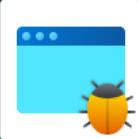
Software Testing at ROGERSOFT
ROGERSOFT TECHNOLOGIES' complete Software Testing (combo pack) Training course will aid in course comprehension. We give you hands-on training and sculpt you into an excellent Software Tester.
Syllabus
Manual Testing
Module 1 Introduction
- What is Software Testing?
- Faulty Software and its impact
- Why is software testing necessary?
- When should we start testing
- Quality
- Quality Management
- Quality Assurance
- Quality Control
- PDCA cycle
- Error, Bug, Failure, Root cause.
- Difference between Testing & Debugging
- Difference between verification and validation
Module 2 Software Development Lifecycle
- Phases of SDLC
- SDLC Models - Different models with benefits and limitation
- Waterfall model
- V model
- Iterative
- Prototype
- Spiral
- Big Bang model
- Impact of SDLC on testing
- DevOps and testing
- Shift Left Approach
Module 3 Test Process
- What is test process?
- Activities in Test process with entry and exit criteria
- Test Planning
- Test Monitoring & Control
- Test Analysis
- Test Design
- Test Implementation
- Test Execution
- Test Closure
Module 4 Software Testing Life Cycle
- Different types of Testing
- Manual, Automation
- White box, Black box, Grey Box
- Levels of Testing
- Component Testing
- Component Integration Testing
Incremental - Top down, Bottom up
Stub, Drivers
Non Incremental
- System Testing
- System Integration Testing
- Acceptance Testing
User Acceptance Testing
Operational Acceptance Testing
Contractual & Regulatory Acceptance Testing
Alpha & Beta Testing
- Non Functional Testing
- Performance Testing
Load Testing
Stress Testing
Stability Testing
Scalability Testing
- Compatibility Testing
- Usability Testing
- Exploratory Testing
- Smoke Testing
- Re-Testing
- Confirmation Testing
- Regression Testing
- Ad-hoc Testing
- Monkey Testing
- Pair Testing
- Buddy Testing
- Gorilla Testing
- Globalization Testing
- Security Testing
- Independent Testing
Module 5 Agile Process Model
- Phases of Agile model
- Agile Frameworks
Scrum - Roles, Artifacts, Ceremonies
- Benefits and Limitations
Module 6 Agile software testing
- Features of Agile testing
- Agile testing principles
- Agile Testing Methodologies
- Test Driven Development (TDD)
- Behaviour Driven Development (BDD)
- Exploratory Testing
- Acceptance Test Driven Development (ATDD)
- Extreme Programming
- Dynamic Software Development Method
- Crystal Methodologies
- Agile Testing Strategies
- Agile Testing Quadrants
- Agile Testing Life cycle
- Agile Test Plan
- Agile Testing - Benefits, Limitations, Challenges, Risks.
Module 7 Test Analysis & Design
- What is a test case?
- When do we write test case?
- Why do we write test case?
- How to write test cases?
- How to create Test case report?
- with the help of a project
- What is Test data?
- What is Test Suite?
- Steps to reproduce a defect
- Test case design technique
- used in Black box testing
Equivalence Partitioning (EP)
Boundary Value Analysis (BVA)
Decision Table testing
State Transition Diagram
Use case design technique
- used in White box
Statement Coverage
Decision Coverage
- used in Experience based testing
Error guessing
Exploratory Testing
Check-list based testing
Module 8 Test Execution
- Defect Report
- How to create Defect report from the Test case report?
- with the help of a project.
- Defect Life Cycle
- Priority
- Severity
- Defect Management
Module 9 Test Reporting
- Test Report
- Test Log
- Test Progress Report
- Test Completion Report
- Release Notes
Module 10 Requirement Traceability Matrix
- What is Requirement Traceability Matrix (RTM)?
- How to create RTM?
- Types of traceability matrix
Forward traceability matrix
Backward traceability matrix
Bi directional traceability matrix
- Benefits
Module 11 Managing Test Activities
- What is test estimation?
- Different estimation techniques
Estimation based on Ratios
Extrapolation
Wide band Delphi
Three point estimation
- Factors associated in test estimation
- Test Schedule
- Risk Management
- Metrics used in testing
- Communicating the status of testing
- Configuration Management
Module 12 Static Testing
- What is tested in Static Testing?
- Benefits of Static testing
- Static testing technique
Static Analysis
Reviews
- Reviews
Review Process
Roles and responsibilities in review
Types of Review
Module 13 API Testing
- What is API testing?
- Purpose of API testing
- Types of APIs
Public API
Partner API
Internal API
Composite API
- API Protocols
REST
RPC
SOAP
- API Methods
GET
POST
PUT
DELETE
- API Testing Types
Unit Testing
Integration Testing
End - to - end Testing
Performance Testing
Functional Testing
Security Testing
Load Testing
Penetration Testing
Reliability Testing
Fuzz Testing
- Tools used in API Testing
- Benefits of API Testing
- Challenges in API Testing
Module 14 Mobile Testing
- Types of mobile testing
Hardware, Software
- Types of mobile application
Native, Hybrid, Mobile web application
- Significance of mobile testing
- Mobile testing strategy
Cross-platform testing
Feature functionality
Type of application
Front-end testing
Multiple network compatibility
Storage
Data to and from
Application flow
- Types of mobile testing
Usability testing
Performance testing
Security testing
Interruption testing
Manual testing
Compatibility testing
Localization testing
Functional testing
Installation testing
Automation testing
Module 15 Bug Tracking Tool
Trello/JIRA
SQL
- What is SQL?
- SQL Commands
Data Definition Lanaguage
- CREATE, ALTER, DROP
Data Manipulation Language
- SELECT, INSERT, UPDATE, DELETE
- What is a Table?
- SQL Datatypes
String Datatype
Numeric Datatype
Date time Datatype
- Aggregate Functions
COUNT, SUM, AVG, MIN, MAX
- SQL Join
Inner Join
Left Join
Right Join
Full Join
- UNION, UNION ALL
- Intersect, Except
- SQL Constraints
NOT Null
Default Key
Check Value
Unique Key
Primary Key
Foreign Key
- Stored Procedure
JAVA Basics
- Introduction
- Features of JAVA
- Java Virtual Machine (JVM) architecture
- Java Native Interface (JNI)
- Java Run Environment (JRE)
- Java Development Kit (JDK)
- Installation of JDK & Eclipse
- Creation of Java project, package and class
- Java keywords
- Introduction to JAVA programming
- Escape Sequence with print statements
- Java Variables - Global, Local and Instance.
- Data types in JAVA
- Type casting
- String literal and String class methods
- Operators in JAVA
- Declarations and Assignments
- Comments in Java
- Basic Java Syntax
- Step by step Execution of Program during Compile time and Run time
- Decision Making Statements in JAVA - if, if-else, if-else-if ladder, Nested if, Switch
- Looping Statements in JAVA - while,do-while,for,for-each
- Jump Statements in JAVA - break,continue
- Methods and its re-usability
- Static variables and methods
- Classes and Objects
- Constructors - Default, No-argument, Parameterized
- Object initialization by reference variable, methods and Constructors
- Final Variables and methods
- Access Specifiers
- Scanner class in JAVA
- Inheritance - Single, Multilevel, Hierarchical
- Method overloading
- Method overriding
- Polymorphism
- Encapsulation
- Abstract class and methods in JAVA
- Interfaces - Inheritance in Interface, Static and final methods in Interface
- JAVA Packages
- Exception Handling
- Collections in Java
Module 2 Automation
- Introduction to Automation testing
- Difference between Automation and manual testing
- When should we go for automation
- Significance of automation in software industry
- Different automation tools available in market
- Pros and cons of Automation testing
Module 2 Automation using Selenium
- Introduction to Selenium
- Selenium Components - Selenium RC , Selenium Grid, Selenium IDE, Selenium WebDriver.
- Selenium WebDriver - Framework, Advantages, Limitations
- Selenese
- Browser Drivers
- Communication between Selenese and browser over JSON wire protocol.
- Selenium jar download and adding to the JAVA project
- End to end scenario implementation.
Module 3 Selenium WebDriver
- Creating JAVA project.
- Adding selenium jar files and Browser Driver to the JAVA project.
- Creating Package and class.
- WebDriver interface - creating object and intializing using browser driver.
- WebDriver command to open, close and maximize a browser window.
- WebDriver command to invoke a webpage in browser.
- WebDriver Commands to get title and url of currently open url in browser
- Navigation commands
- Locating single and multiple webelements in a webpage
- Locators / Object identification methods
- Locating web elements using Xpath - Absolute and Relative
- Different variations in Relative Xpath
- Web element commands
- Handling synchronization issues using Wait commands
- Handling static and dynamic Dropdown
- Handling Mouse hovering
- Handling Drag and drop
- Handing Right click and double click
- Handling Keyboard keys
- Handling Alerts
- Handling iFrame
- Automate screenshots capture - multiple, partial and full
- Handling Scroll down
- Handling multiple windows or tabs
- Handling file upload to a web element.
- Execution of scenarios in different browser(IE/Chrome/Firefox)
Module 4 Test Automation Framework
- Introduction to test automation frameworks
- Types of framework in selenium - Data driven, Keyword driven and Hybrid.
- Advantages of using frameworks in Selenium
- TestNG framework - advantages and uses
- Downloading and adding TestNG to the JAVA project
- Creating TestNG class
- Annotations in TestNG and its default priority
- Executing a program to automate invoking a webpage in TestNG
- Creating TestNG suites
- Prioritizing TestNG suites
- Fetching TestNG report
- Assertion using TestNG
- Parameterize using XML file.
- Creating xml file from TestNG class
- Data driven parameterisation using Data Provider
- Cross Browsing using TestNG
- Parallel Browsing using TestNG
- Reading data from Excel sheet.
- Page Object Model Framework
- Page Factory class
Module 5 Build Automation tool - Maven
- Maven – Introduction to maven
- Setting up of Maven
- Creation Maven project
- Adding files required for automation as dependencies.
- Executing the maven projects
- Basics of GIT and Jenkins
Module 6 Appium
- Introduction to Appium Selenium Mobile Testing
- Installation steps for Appium
- Inspecting elements in mobile app & mobile browser(Chrome)
- Execution of tests in mobile app & mobile browser
- Automate your application
JMeter
- Introduction to Jmeter
- Installation of Jmeter
- Recording tests using Jmeter
- Adding config elements to the test script
- Adding Listeners to the test script
- Parameterize with test data
- Correlation
- Adding assertions to the test script
- Plugins Manager
- GUI mode of Execution
- Non-GUI mode of Execution
ISTQB Training
Contact Admin for more details
Placement
No.1 in Software Testing Placements

Basil Biju
BTech - IT (2023)
Ruby Seven Studio, Infopark
Quality Analyst

Artha P Satheesh
BTech - Computer (2019)
Codepoint Software PVT LTD, Infopark
Associate Software Tester

SNEHA FRANCIS
Degree - BTech Civil (2019)
Practicesuite India (P) Ltd, SmartCity
Java Developer

Test Reg
PG - MSW (2021)
MariApps Marine Solutions Pvt Ltd, SmartCity
Test Engineer
Frequently Asked Questions
- Individual attention.
- 100% placement assistance.
- Experienced faculties.
- Liberal fees structure.
- We are following globally accepted syllabus.
- Almost every student who is studying here are getting placed.
- We are having so many client companies at infopark and technopark.
- We offers grooming section for our students with our experts for getting idea on how to attend an interview.
Non IT / IT candidates
Join with Us
Are you searching for a leading Software Development and Software Testing Training Institute?
Why Should You Prefer Us?
We near to the Completion of One Decade with 100% Placement Records
Rogersoft offers training from Beginners level to Experts level.





